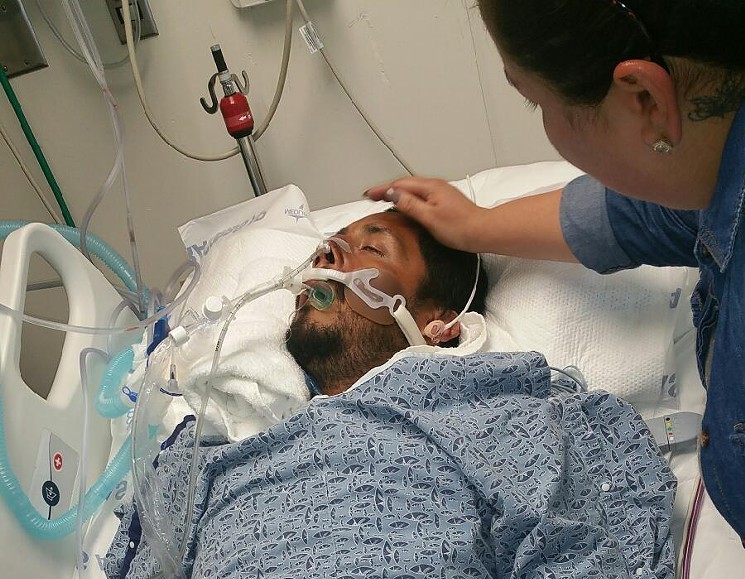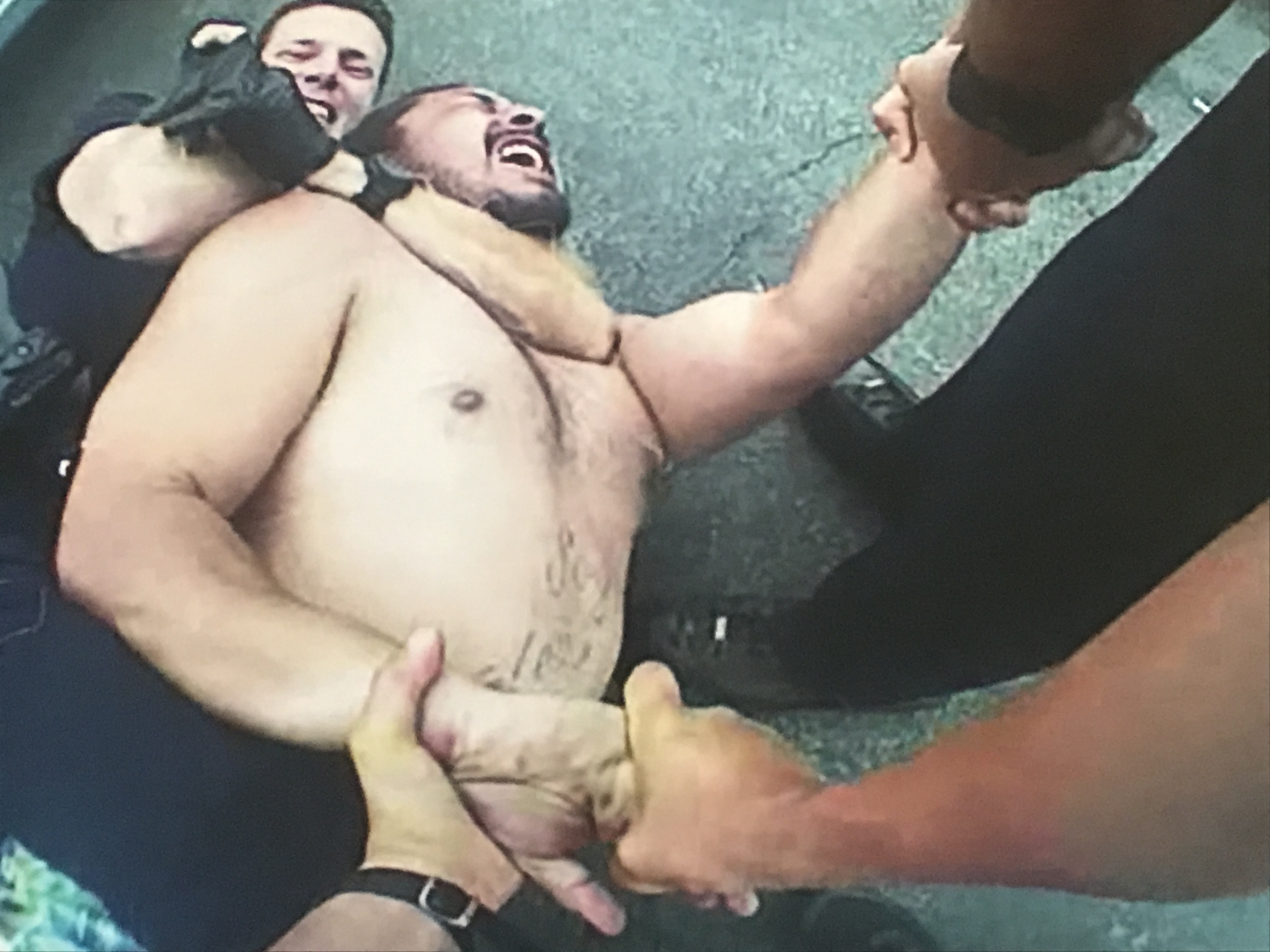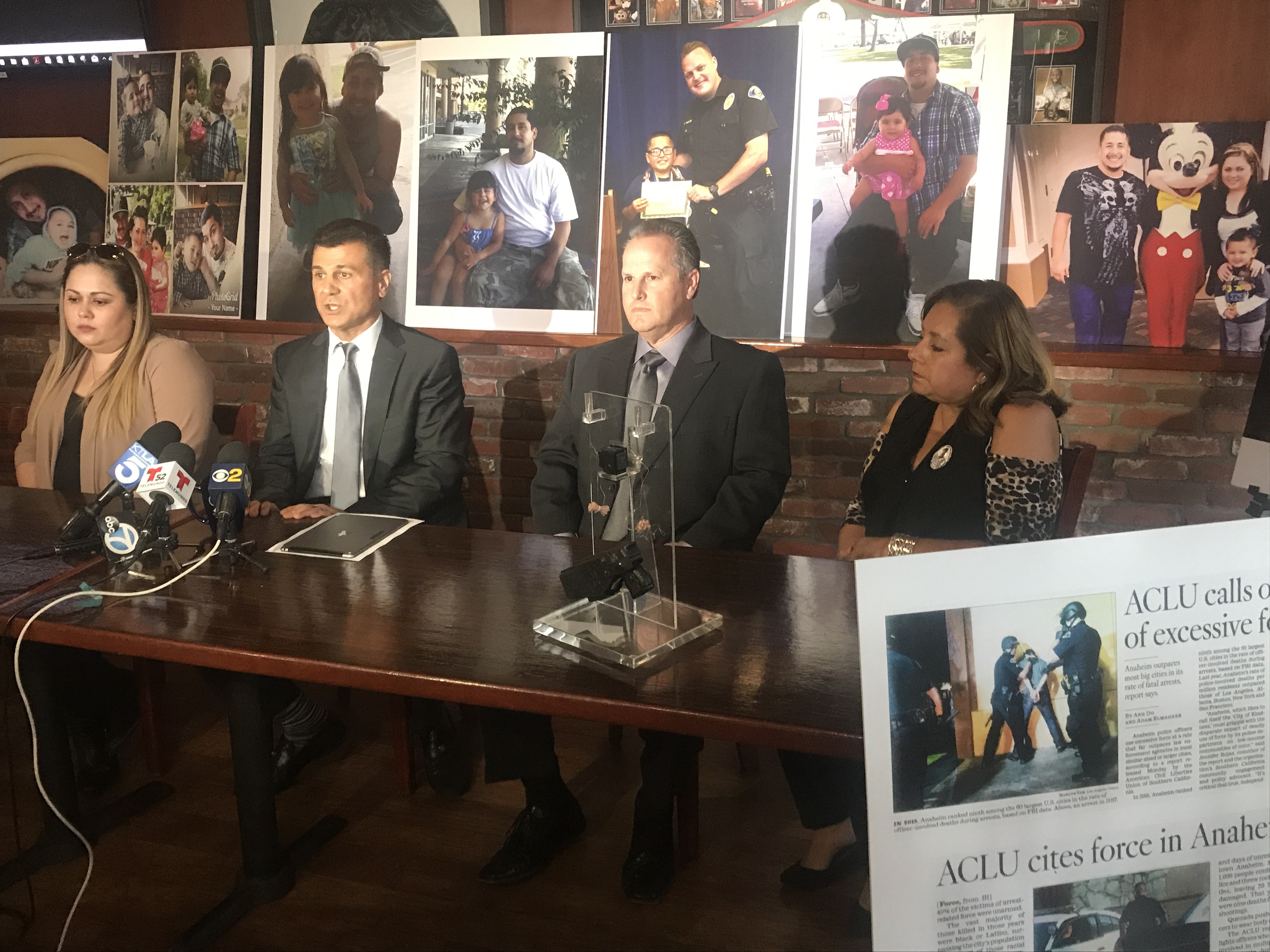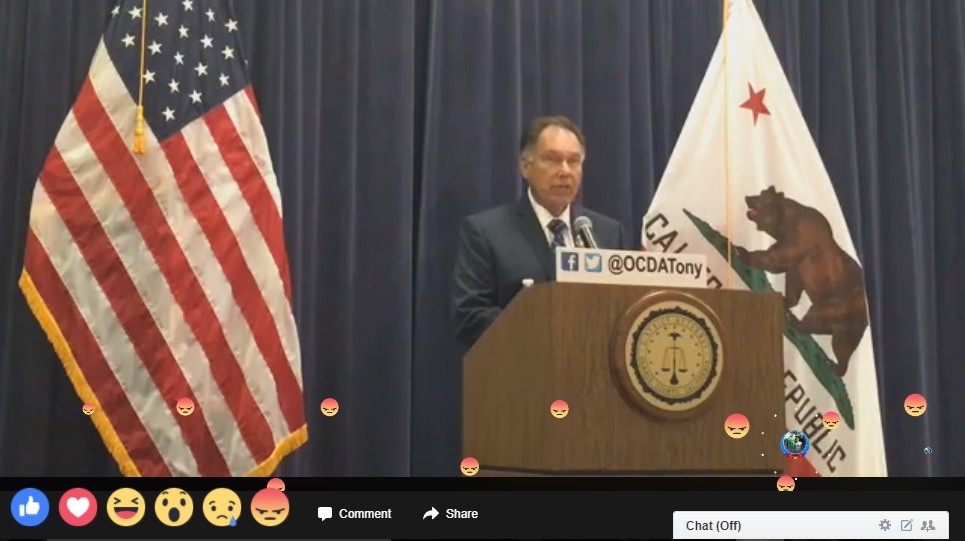 UPDATE, NOV., 30, 5:10 P.M.: Family members of Vincent Valenzuela, a father killed by Anaheim police last year, gathered for a press conference this afternoon in Los Angeles. The Orange County District Attorney’s (OCDA) office released body camera footage yesterday during a briefing of their own. Garo Mardirossian, an attorney retained by Valenzuela’s family, promised a different look at the videos that captured the events leading up to Valenzuela’s death, including the carotid restraint hold used by an officer that left him unconscious in a 7-Eleven parking lot.
UPDATE, NOV., 30, 5:10 P.M.: Family members of Vincent Valenzuela, a father killed by Anaheim police last year, gathered for a press conference this afternoon in Los Angeles. The Orange County District Attorney’s (OCDA) office released body camera footage yesterday during a briefing of their own. Garo Mardirossian, an attorney retained by Valenzuela’s family, promised a different look at the videos that captured the events leading up to Valenzuela’s death, including the carotid restraint hold used by an officer that left him unconscious in a 7-Eleven parking lot.
“Here we are talking about yet another young man who had committed no crime when the police arrived, and yet, by the end of that day, he was brain dead,” Mardirossian said. “You would think the Anaheim Police Department, not being too far from the Fullerton Police Department, would have learned a lesson or two from what happened to Kelly Thomas.”
Mardirossian represented Ron Thomas, Kelly’s father, in a civil suit against the Fullerton Police Department and won a $4.9 million settlement two years ago. While District Attorney Tony Rackauckas downplayed comparisons between the two cases yesterday, Mardirossian focused on their parallels. Five years to the day, both men were taken off life support on July 10 after fatal encounters with police. They also suffered from mental health conditions and were homeless at the time. Neither were armed.
 Before Mardirossian played the video sequence related to Valenzuela’s death, he excused the deceased man’s two children and their grandfather from the room. The footage proved too disturbing for them. Once they left, the attorney stressed the importance of the evidence he was about to show. “The Anaheim Police Department fought tooth and nail to stop you and the public from seeing the body cameras worn by these officers,” he said. “You’ve got to wonder why? Cameras don’t lie.”
Before Mardirossian played the video sequence related to Valenzuela’s death, he excused the deceased man’s two children and their grandfather from the room. The footage proved too disturbing for them. Once they left, the attorney stressed the importance of the evidence he was about to show. “The Anaheim Police Department fought tooth and nail to stop you and the public from seeing the body cameras worn by these officers,” he said. “You’ve got to wonder why? Cameras don’t lie.”
Mardirossian stressed that surveillance footage from the laundromat showed Valenzuela walking in with a calm demeanor before officers tried to contact him, a contrast from the portrayal of suspicious behavior put forth by the OCDA. “The struggle began because the police instigated it,” he added. The attorney interpreted key use of force moments caught on camera, from officer Daniel Wolfe repeatedly tasing Valenzuela, including in the chest, to later applying the carotid control hold that ultimately led to his death. While the footage played, Marie Cofinco, Valenzuela’s aunt, looked away and broke down in tears.
The video sequence Mardirossian compiled differed in size from the thumbnails assembled by the OCDA. “Sure, the Orange County DA had [the videos] playing in the background, but there was no focus on what you just saw,” he told media. “What’s obvious is that these officers were using excessive force on a young man who was doing nothing other than trying to stay alive. They had him choked out and he was trying to breathe. You can see the color of his face had turned purple.”
He criticized Sgt. Daniel Gonzalez, who arrived on scene to supervise the situation, for telling Wolfe to continue applying the cartoid control hold when both of Valenzuela’s hands were being held. The attorney further argued that Gonzalez should have called for deescalation tactics at the time. Instead, Gonzalez told Valenzuela to “stop resisting” multiple times when he could no longer mount any meaningful struggle.
Family photos of Valenzuela with his children formed the backdrop of the press conference. Patricia Gonzalez, their mother, spoke briefly about how they’ve been impacted since losing their father. “It’s been very hard for them,” Gonzalez said. “They have their episodes every now and then. As a mother, there’s nothing I can do to make it better for them.”  ORIGINAL POST, NOV., 30, 6:30 A.M.: The Orange County District Attorney’s office released body camera footage showing Anaheim police leaving a homeless man in a coma after a confrontation last year. The agency already cleared two officers in September of any wrongdoing in the incident that ended with Vincent Valenzuela, 32, being pulled off life support days later. The evidence was presented during a news conference held yesterday afternoon after a judge lifted a protective court order on the footage.
ORIGINAL POST, NOV., 30, 6:30 A.M.: The Orange County District Attorney’s office released body camera footage showing Anaheim police leaving a homeless man in a coma after a confrontation last year. The agency already cleared two officers in September of any wrongdoing in the incident that ended with Vincent Valenzuela, 32, being pulled off life support days later. The evidence was presented during a news conference held yesterday afternoon after a judge lifted a protective court order on the footage.
The public disclosure is part of a new OCDA policy on releasing video and audio evidence whenever possible in police shooting and in-custody deaths.
Despite having already reached a legal conclusion, assistant district attorney Ebrahim Baytieh began the 46-minute long news conference going over the particulars of the case (Read the Weekly‘s report on the OCDA’s investigation for a refresher). He described the training officers Daniel Wolfe and Woojin Jun had received both in narcotics and “carotid restraint” techniques. Police suspected Valenzuela had shattered a meth pipe in a laundromat when they encountered him on July 2, 2016 after responding to a call of a man suspicious pacing outside a nearby home. After a struggle that continued at a 7-Eleven parking lot across the street from the laundromat, Wolfe put Valenzuela in the hold until he lost consciousness.
“There’s a little bit of misunderstanding of this technique,” Baytieh said. “It really has nothing to do with trying to stop somebody from breathing.” After explaining the hold, the assistant district attorney played footage captured by the officers’ body worn-cameras as well as surveillance video from the laundromat and 7-Eleven.
“Did you break a pipe or something?” Wolfe asked Valenzuela, who ignored his question and reached into his duffel bag on the floor by a washing machine. Wolfe ordered him to stop and put his hands behind his back, reportedly after seeing a screwdriver in the bag. “Get on the ground,” the cop continued after physically trying to detain him. “I didn’t do anything!” Valenzuela said. Jun put him in the carotid restraint hold on the ground. “I can’t breathe!” Valenzuela pleaded. Wolfe turned next to his Taser, whose zaps ended up breaking the hold and allowed Valenzuela to wiggle free.
Wolfe tased Valenzuela again outside the laundromat, but at no time did Baytieh indicated where the prongs struck him, only that they stuck to his shirt. Garo Mardirossian, an attorney retained by the Valenzuela family, claimed shortly after Valenzuela died that medical records showed taser marks to his chest, an area of the body the weapon manufacturer cautions against striking. Valenzuela broke free after kicking off one officer and ran across the street to a 7-Eleven. Cops wrestled him to the ground again when Wolfe applied the carotid control hold. Sergeant Daniel Gonzalez arrived on scene and began supervising the use of force.
Valenzuela faded wheezes can be heard before Wolfe put his full body weight on top of him. Officers cuffed a quiet Valenzuela and turned him over on his side. “He’s purple right now, so I want to make sure he’s breathing,” Gonzalez said. “I’m not finding a pulse,” another officer added while checking for one. Valenzuela suffered cardiac arrest three times but paramedics restarted his heart. He’d never regain consciousness again, though, after being transferred him to West Anaheim Medical Center. Doctors took him off life support on July 10, 2016. An autopsy determined complications of asphyxia while under the influence of meth as the cause of death.
 With the OCDA trying to become more social media savvy, the entire news conference was broadcast on Facebook live. When District Attorney Tony Rackauckas took the podium to address reporters, angry-faced emojis from Valenzuela’s family members floated across the screen. “There’s no indication [the hold] was improperly applied,” Rackauckas responded to a reporter’s question. “It can be lethal. In this case, it was.”
With the OCDA trying to become more social media savvy, the entire news conference was broadcast on Facebook live. When District Attorney Tony Rackauckas took the podium to address reporters, angry-faced emojis from Valenzuela’s family members floated across the screen. “There’s no indication [the hold] was improperly applied,” Rackauckas responded to a reporter’s question. “It can be lethal. In this case, it was.”
The Anaheim Police Department’s policy on the carotid control hold notes its potential for injury and advises it only be used in cases where a person is violently resisting or threatens to harm officers. Police are discouraged from applying the technique on pregnant women, elderly folks and “obvious juveniles.” But OCDA doesn’t address policy in its investigations, only criminal culpability. Rackauckas hopes the release of video footage in cases like Valenzuela’s builds public trust in their legal conclusions. “We have good police officers doing good work,” he added.
Mardirossian is planning to file a lawsuit against the police on behalf of Valenzuela’s daughter and his son who had graduated from Anaheim PD’s Jr. Cadet program before his father’s death. The law firm calls the carotid restraint technique a “choke hold” in announcing a press conference this afternoon in Los Angeles where video footage, including portions the OCDA apparently didn’t show, will be played and discussed.

Gabriel San Román is from Anacrime. He’s a journalist, subversive historian and the tallest Mexican in OC. He also once stood falsely accused of writing articles on Turkish politics in exchange for free food from DönerG’s!

